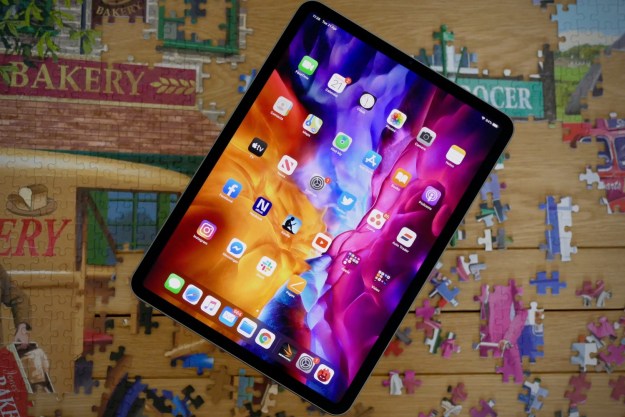While the new Mac Pro and iMac Pro are aimed squarely at the same group of people, they’re actually quite different beasts, each with their own pros, cons and considerations to take into account. In this guide, we’ll lay out everything you need to know about them.
And if you’re thinking about getting a regular iMac, we’ve got you covered there too.
Design

We’ll start with the buzzword of the day: Modularity. In a candid interview with reporters back in 2017, Apple acknowledged that it had plenty of customers that wanted a modular system that could be altered and upgraded as necessary. You see that in the Mac Pro, which features various modules that can be added at will, and a design that lets you access any part of the machine.
Externally, the Mac Pro’s design is incredibly distinctive. It features steel handles coupled with an aluminum housing perforated by a latticework of cooling holes. These are designed to keep the computer chilled without deafening you with overpowered fans. The design has drawn unfortunate comparisons to a cheese grater, but we’re sure Apple would prefer you to harken back to the Power Mac G5 and its somewhat similar perforated front section.

The iMac Pro is very different, following as it does the famous all-in-one iMac design so beloved over the years, albeit in a space gray colorway distinct from the usual iMac silver. That design, though — incorporating a high-resolution display and computer components into a single frame — means the iMac Pro is anything but modular. While it is possible to upgrade things like the memory, it’s a very involved process that’s beyond the scope of most home users; Apple, for example, advises that the RAM “isn’t user-accessible” and recommends you take your machine to an Apple Store. When you’re building such a tightly integrated computer, modularity has to be sacrificed in order to cram everything in.
Still, the iMac Pro may be more up your street if you love the sleek, all-in-one look of the iMac but don’t want to compromise on performance.
Features

Given the Mac Pro’s focus on modularity, Apple wants its users to be able to access any part of the system in a flash. With that in mind, the Mac Pro features a top-mounted handle that, when lifted, pulls away the entire exterior covering of the computer, revealing its high-powered guts. It’s a handy way to quickly get to the parts you need to.
While the default Mac Pro case comes with feet, these can be swapped out for wheels should you need to move the machine around your office or studio.
On top of the enclosure are two Thunderbolt 3 ports, supporting up to 40Gb/s transfer speeds, while two more Thunderbolt 3 ports are on the back of the machine. You also get two USB 3 ports and two 10Gb Ethernet ports on the rear, plus a 3.5mm headphone jack. Additional Thunderbolt, DisplayPort and HDMI ports are offered depending on which graphics card option you go for.
The iMac Pro, on the other hand, comes with a slightly different array of ports. You get four ports each for Thunderbolt 3 and USB 3, plus an SDXC card slot and 3.5mm headphone jack. Note that you only get one 10Gb Ethernet port, though.
Elsewhere, we’d be remiss not to talk about the iMac Pro’s built-in 5K display. At 27 inches diagonally and with a 5,120 x 2,880 resolution, this is a fantastic display for tasks like video- and photo-editing, which require plenty of screen real estate. It features 500 nits of brightness and uses the P3 wide color gamut for excellent clarity and color reproduction. Unfortunately, as with all iMacs, you can’t rotate or adjust the height of the display.
Performance

Now for the meat of the argument. While both the Mac Pro and iMac Pro are true powerhouses in the computing world, there are some significant differences.
Although we haven’t yet been able to test the Mac Pro, Apple has laid out its specs in detail. The base configuration comes with an eight-core 3.5GHz Intel Xeon W processor, 32GB of ECC memory, a 256GB SSD and an AMD Radeon Pro 580X graphics chip. That arrangement can be expanded hugely to include a 28-core 2.5GHz Intel Xeon W processor, 1.5TB of ECC memory (yes, 1.5TB), and 8TB of SSD storage.
You can also add two graphics MPX Modules (see below), each of which be be configured to contain an AMD Radeon Pro Vega II Duo graphics setup with two graphics cards, meaning you can have four graphics cards in a single machine.
As we alluded to before, a key part of the Mac Pro is its modularity. In practice, that means there’s a huge array of expansion slots available. The Mac Pro works on a system of ‘MPX Modules’, each of which provides an x16 PCIe 3.0 slot for graphics, an x8 PCIe 3.0 slot for Thunderbolt, plus DisplayPort video routing. Alternatively, these MPX Modules can support one full-length, double-wide x16 slot and one full-length, double-wide x8 slot. Aside from the MPX system, you also get three full-length PCIe 3.0 slots. In other words, you won’t be short of expansion options.

As if that wasn’t enough, Apple gives you the choice of adding an Afterburner accelerator card, which boosts ProRes and ProRes RAW codecs in apps like Final Cut Pro X and supported third-party programs.
While the iMac Pro is nowhere near as modular, it still packs plenty of power under its svelte hood. The default eight-core 3.2GHz Intel Xeon W processor can be upgraded all the way up to an 18-core 2.3GHz Intel Xeon W chip, while you can pack it with up to 256GB of ECC memory and 4TB of SSD storage. The graphics options range from an AMD Radeon Pro Vega 56 to a Vega 64X, which gives you a whopping 16GB of video memory and 24 teraflops of half precision power.
While the iMac Pro can hold its own in terms of raw performance, the customizability of the Mac Pro means it’s the one to go for if you need ultimate power. That said, when comparing base models, the iMac Pro is more affordable, and don’t forget it also comes with a superb 5K display built in. Meanwhile, the Mac Pro’s companion display, the 6K Apple Pro Display XDR, starts at $4,999. While that’s surprisingly affordable for a high-quality reference display, it’s a useful reminder of the value of the iMac Pro’s screen-and-machine combination.
The Mac Pro’s modularity wins out

Although Apple has a (somewhat unfair) reputation for being overpriced, both the Mac Pro and iMac Pro are actually very reasonably priced compared to equivalent Windows machines, although the comparison isn’t exactly straightforward.
The question then comes down to how much power you really need. Obviously neither machine is designed for everyday consumers, so if you’re considering one of these beasts then you likely already know how much performance you require.
If it’s a no-holds-barred monster of a machine you need, which we assume you do, the Mac Pro is the one to go for. Its wide-ranging modularity means you can configure it to meet whatever needs you have. Even the default configuration is an impressive sight (with the exception of the disappointing 256GB capacity of the SSD).
The iMac Pro sits in between the Mac Pro and a more down-to-earth machine like the iMac. As great as the iMac Pro is, it’s harder to recommend, especially since the Intel Core i9-9900K recently came to the top-of-the-line 5K iMac at a more affordable price.
Whichever you go for, give it a lot of thought — starting at $5,999 and $4,999 for the Mac Pro and iMac Pro respectively, these are hardly impulse buys. Both, however, will give you incredibly powerful tools no matter your workload.
Editors' Recommendations
- iMac deals: New, renewed and refurbished iMac computers
- Best Apple deals: Save on AirPods, Apple Watch, iPad, MacBook
- The 5 best MacBooks for video editing in 2024
- Google Drive vs. Dropbox: which is best in 2024?
- MacBook Pro 16 vs. MacBook Pro 14: The important differences




